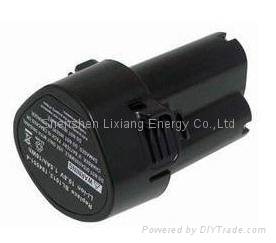Life of rechargeable batteries
Rechargeable cordless tool batteries self-discharge more rapidly than disposable (zinc-carbon and alkaline ) / primary batteries, especially nickel-based batteries; a freshly charged NiCd loses 10% of its charge in the first 24 hours, and thereafter discharges at a rate of about 10% a month.
However, modern Rechargeable cordless tool batteries lithium had designed to reducing the self-discharge rate to a relatively low level (but still poorer than for primary batteries). Most nickel-based batteries are partially discharged when purchased, and must be charged before first use.
Although rechargeable cordless tool batteries have their energy content restored by charging, some deterioration occurs on each charge/discharge cycle.
* Low-capacity nickel metal hydride (NiMH) batteries (1700-2000 mA·h) can be charged for about 1000 cycles,
* whereas high capacity NiMH batteries (above 2500 mA·h) can be charged for about 500 cycles.
* Nickel cadmium (NiCd) batteries tend to be rated for 1,000 cycles before their internal resistance increases beyond usable values.
* Lithium ion batteries have 1200 over cycles rechargeable.
For now all the cordless tool batteries using Li-Ion Battery cause they have many advantages i.e. economic, environmental, long life cycles.
However, modern Rechargeable cordless tool batteries lithium had designed to reducing the self-discharge rate to a relatively low level (but still poorer than for primary batteries). Most nickel-based batteries are partially discharged when purchased, and must be charged before first use.
Although rechargeable cordless tool batteries have their energy content restored by charging, some deterioration occurs on each charge/discharge cycle.
* Low-capacity nickel metal hydride (NiMH) batteries (1700-2000 mA·h) can be charged for about 1000 cycles,
* whereas high capacity NiMH batteries (above 2500 mA·h) can be charged for about 500 cycles.
* Nickel cadmium (NiCd) batteries tend to be rated for 1,000 cycles before their internal resistance increases beyond usable values.
* Lithium ion batteries have 1200 over cycles rechargeable.
For now all the cordless tool batteries using Li-Ion Battery cause they have many advantages i.e. economic, environmental, long life cycles.
